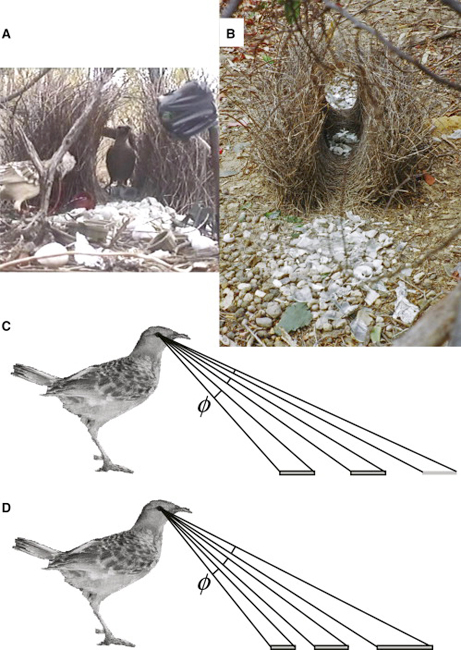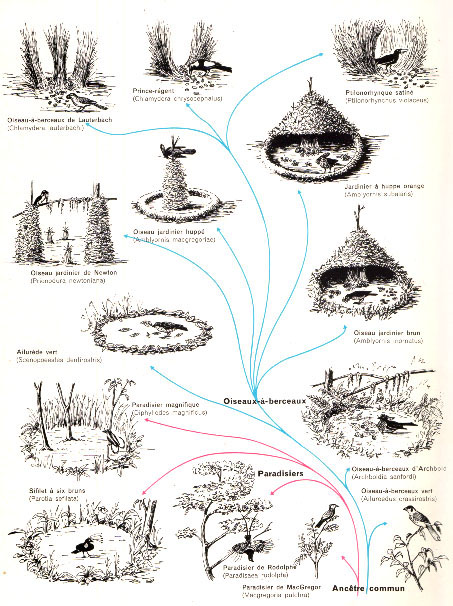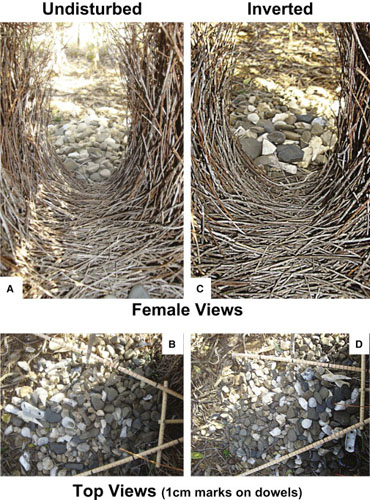A forced perspective highlights the male?
A recent Nature News (
here) describes an investigation of bowerbirds that attract females with a parade in a specially prepared (court) before a sort of cradle of twigs where the female is watching , The researchers, Endler, JA, et al. (2010) show that males of some Australian bowerbirds hold the stones of their court of the smallest to the largest tunnel in the distance. (See Figure 1c) This size gradient created by the researchers an optical illusion that makes them appear larger and more striking.

Fig 1: a) the male front, watching the arrival of the female who appears on the other side of the cradle. b) the court is filled with pebbles graded in size. c) Normally the same size objects are viewed at an angle decreasing with distance-d) males Chlamydera nuchalis hold the stones of their court of the smallest to the largest tunnel in the distance, they are seen by the female who looks angles constant despite the distance. [img ] Source Endler, JA, et al .. (2010).
birds that attract the females by their buildings rather than a dramatic plumage. According
C. Lavorel, these
Bowerbirds, the "bowerbird" in French, should not be confused with birds of paradise, and in particular they have no feathers but impress with their spectacular constructions "that can be simple domes or structures designed with a sort of tunnel and a courtyard paved with colored objects (berries, flowers, caps and other human objects), see fig 2.
 Figure 2: Phylogeny likely bowerbirds. [ img] Source: Grange. (1973)
Figure 2: Phylogeny likely bowerbirds. [ img] Source: Grange. (1973)
In these bowerbirds, according Maxmen, Amy. (2010) males spent up to 80% of their time treating this court
(Jacques Dutronc would perhaps be called a trap Oiselle extra a toy.)  Fig 3: bowerbird impress with their constructions. [ img] source: Greg Miles
Fig 3: bowerbird impress with their constructions. [ img] source: Greg Miles When seeking a partner, the female stands in the cradle (tunnel) and the court observed that the male attracts with raucous cries, jumping, and waving a colored object. cf Fig 1a.
A male who creates a gradient of stones and an optical illusion?
Maxmen, Amy. (2010) described in Nature News, how
John Endler et al. (2010) , Deakin University in Geelong, Australia, studied
Chlamydera nuchalis whose cradle is made of a sort of tunnel 60 centimeters long, which ends with a 'court' (see ;
video ).
The researchers took pictures from the tunnel and realized that the pebbles lining the floor of the court were arranged by size, smallest to largest creating an optical illusion called forced perspective. See Fig 4a) and 4c).
 Fig 4: the pebbles lining the floor of the court were arranged by size, smallest to grands.Quand researchers have reversed the gradient size, males have restored a gradient in three days [img ] Source: Endler, JA Endler, SC & Doerr, NR (2010).
Fig 4: the pebbles lining the floor of the court were arranged by size, smallest to grands.Quand researchers have reversed the gradient size, males have restored a gradient in three days [img ] Source: Endler, JA Endler, SC & Doerr, NR (2010). When the researchers reversed the size gradient, Fig 4 b) and 4 d) males have restored a gradient in three days and repeated the illusion complete in 3 weeks.
This clearly indicates that this gradient is important for them, "says Endler. Normally
objects of similar size are seen at an angle decreasing with distance cf Fig 1 c) but with a gradient from the smallest pebble to the largest tunnel in the distance, they are viewed by the female who looks angles constant despite the distance.
If birds are like us, the court would appear smaller than it is and the contrast bird bigger than he really is. James Ha, a researcher in cognitive behavior at the University of Washington
in Seattle, think this is a unique case:
"I Can not Think of Any Other animals clearly" That uses optical illusions. " One could imagine that this behavior reveals the cognitive abilities of males than females and prefer the more malignant, the authors believe.
But Ha argues that this could be an innate behavior ( Hardwired ) that not require great cognitive abilities. also an illusion performed well could mean that a case has a effective male to pick up objects, flying objects colored to protect his work and other thieves. Extreme gradient may simply reflect an environment rich in objects. In fact, suggest that the birds would take aesthetic decisions when they arrange their cradles and meticulously over irritates many researchers. "I would not like to read this research and we go to say that these birds are smarter than Michelangelo," says Gerald Borgia, a biologist at the University of Maryland in College Park.
- A more comprehensive paper on this research in Nature here
The forced perspective
perspective and texture density gradient are two mechanisms used to assess the sizes despite the distances among others (size perspective, shading, interposition, saturation) (Rock, I. (1984). It is based -among others - on the lines of flight and reduced apparent size of objects of known size. Distort lines escape or size gradient can make objects appear farther than they are and thus give them a apparent size distortion.
F ig 5: [img ] A distorted perspective gives the impression that the woman on the right is much more grande.Source: Myers, DG (1998). The beauty of the male: female because of selective ...
We know that male birds of many species are equipped with beautiful plumage that attracts females (one can not help thinking of the Peacock).

Fig 6: the peacock male attracts females by their beautiful plumage. The female peacock, very discreet, chose the male for its beautiful plumage. [ img] Source: Christopher EYQUEM Free Art License
This classic example shows that evolution does not result from a competition for survival, but for reproduction. "In all species, it takes compromise between survival and characteristics such as frequency of reproductive investment in parental care and the number of offspring (Campbell p. 1238) This example classic shows that evolution does not result from a competition for survival, but for reproduction. "In all species, it takes compromise between survival and characteristics such as frequency of reproductive investment in parental care and the number of offspring (Campbell p. 1238) Clearly
this magnificent bird tail makes it more vulnerable to predators! If a peacock who has appeared subdued colors and is not cluttered with a huge tail, (it certainly happened) it probably would survive much longer ... but as females do not know, peacocks today are not descendants of this individual "prudent", but rather those who liked to females, who behaved in ways we would call reckless and flamboyant. It is indeed females choose their partners from these birds. "Since breeding event is often more costly for females than for males, females tend to be more selective in choosing their partners (P. Raven 1125)."
Females Birds are often equipped with plumage much more discreet. (See Fig. 6) is generally attributed this difference to the different investment in breeding. Females have invested considerable energy in a few eggs and selection has favored those who entrust their genes and therefore the success of their eggs with caution, whereas in males - which produce sperm more easily - they are the most attractive to females who are most descendants, even if they are attacked by predators.
"You can interpret most of the differences in reproductive strategy between the sexes by comparing the respective parental investments of males and females. Numerous studies have shown that parental investment of females is significant. One reason is that eggs are much larger than sperm; 195 000 times in humans! In addition, some groups of animals, females are responsible for gestation and lactation, reproductive functions expensive. [...]
The consequence of such differences in parental investment is that the sexes should be confronted with very different selective pressures. (Raven p. 1125). Any
transposition to humans and to differences in parental investment or household would be very inappropriate, it would be anthropomorphism in reverse ...
.-)




